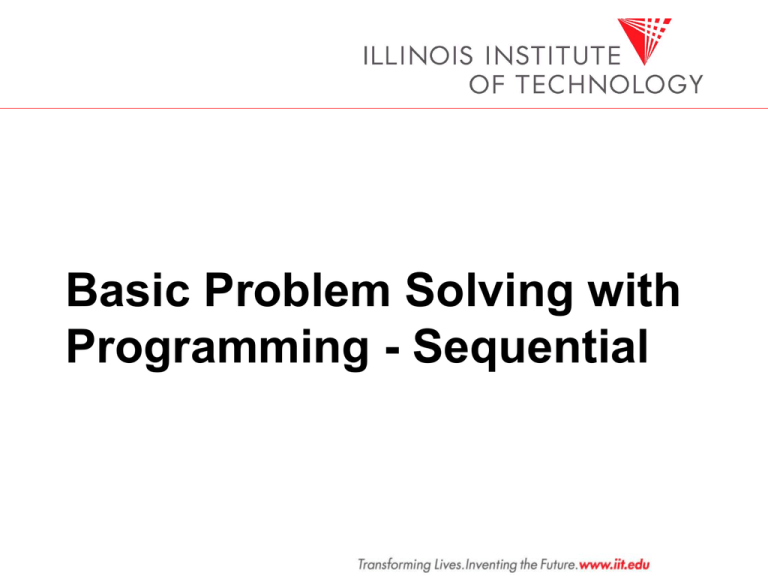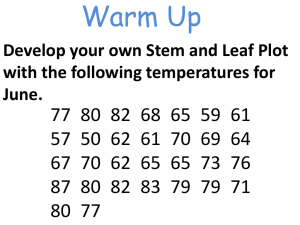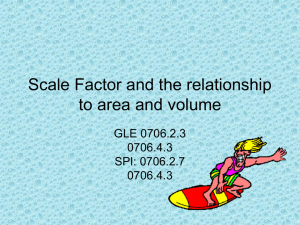slides
advertisement

Basic Problem Solving with Programming - Sequential Basic Problem Solving with Programming When you have been given a problem to solve with programming, the first step is to try to understand what the problem is asking for and the steps involved to solve the problem. Then you can start to write code to solve the problem. Most of the basic programs we will start with can be classified as Input-ProcessOutput Input-Process-Output (sequential processing) 1. What are the inputs? What format are they in? (e.g., integer, floating-point, character, or string) How do you get them? (e.g., prompt user, argument when run the program, or read from file) 2. How do you get from inputs to the outputs you want (process)? What are the calculation steps? To follow these steps, what else do you need? Other variables, constants, conversion? (besides input and output variables) Libraries (e.g., for calculations). 3. What are the outputs? What format are they in? How do you output them? (e.g., on screen or to a file) Decomposition The first step to solving any problem is to decompose the problem description. We can do this in the following steps. 1. 2. 3. 4. 5. Identify all of the nouns in the sentence. Eliminate redundant or irrelevant information. Identify all of the verbs in the sentence. Link you inputs, processes, and output Use external knowledge to complete your solution Example: Given the 3 dimensions of a box (length, width, and height), calculate the volume. 1. Identify all of the nouns in the sentence. Given the 3 dimensions of a box (length, width, and height), calculate the volume. Once these nouns are identified, they should be grouped into one of two categories: • Input (items I either already know or am getting from the user) • Output (items that I find out by manipulating the input) 2. Eliminate redundant or irrelevant information. There may be some information in the problem description that made it into our input/output chart that we really don’t need to solve the problem (that is, not all of the nouns may be relevant). Also, there may be some nouns that appear redundant (information we already have in our table, just in a different form). Input Dimensions - We don’t need the noun dimensions here because we already have length, width, and height. Length Width Height Box - We do not need the box to calculate volume if we know the dimensions, not needed. Them - Another word for dimensions, not needed. Output Volume 3. Identify all of the verbs in the sentence. The verbs in the problem specification identify what actions your program will need to take. These actions, known as processing are the steps between your input and your output. Given the 3 dimensions of a box (length, width, and height), calculate the volume. 4. Link you inputs, processes, and output This step is as simple as drawing lines between the relevant information in your chart. Your lines show what inputs need to be processed to get the desired output Input Length Width Height Processing Output Calculate Volume 5. Use external knowledge to complete your solution In the solution, we have used a general verb calculate. It is at this point at which we are required to determine what “calculate” means. In some arbitrary problem, calculate could refer to applying some mathematical formula or other transformation to our input data in order to reach the desired output. In this case, our elementary geometry tells us that the volume of a box can be found using the following formula: Volume = length * width * height Decomposition Problem You have a store that sells lemons and oranges. Oranges are $.30 each and lemons are $.15 each. For a certain number of oranges and lemons, calculate the total bill. More Advanced Problem Solving • The decomposition approach is fine for fairly simplistic input-process-output problems, but what happens when our problems are more involved? • “flow of control” models in programming – – – – Sequential Selection Iteration Functions Possible Errors • Syntactic Errors – compiler/interpreter finds • Semantic Errors – logic or formula errors, conversion errors, etc. • Thematic Errors – Not solving the correct problem!











